

|
Back to |
| The Front Page |
| People |
|
Part Three, Alman Memoir: Moving to South Florida |
|
by Bob Alman posted on December 8, 2019
|
Writing in third-person comes naturally to an 80-year-old recalling events from decades past. It may help with objectivity, with settling the huge question of fairness to the characters who made a difference for good or ill, in the story. He was only a character, himself. So now he describes as he recalls it now - for you and for himSelf - what was in his mind, what his intentions were, and how all that could have possibly happened, so long ago.
By the 90's the San Francisco Open, played with a maximum of 64 players in three flights over four days, was the strongest tournament in the country, with more top-ranked players competing than in the USCA Nationals, held on the other coast. The club was flourishing along with the Open, but the club had achieved everything it said it wanted to achieve, so although its champions were still winning the significant tournaments, there was no "new generation" of great players appearing on the lawns. With no "vision" of the future to organize and work for, the club -invisibly, inevitably - started to decline.
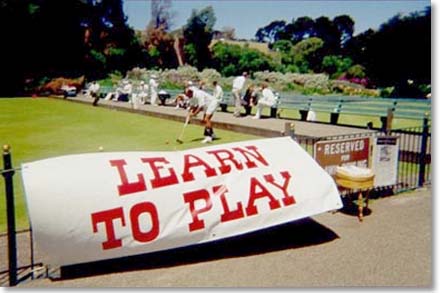
|
| Huge signs in Golden Gate park during the Open invited the public to free Saturday courses on the Stern Grove lawns. |
Much of the story of the club has already been told online and in print - including Bob's three-volume MONOGRAPH SERIES ON CLUB-BUILDING, ORGANIZATION AND MANAGEMENT, financed by the Croquet Foundation of America, published in 1992 and still available from the USCA. Some of the San Francisco Croquet Club highlights of the last 15 years of the last century are:
- Enlisting the support of San Francisco's Recreation and Parks Advisory Commission to rent the bowling lawns to expand the SF Open, ultimately to 64 players on seven lawns (including Stern Grove and the lawns of the Oakland Bowling Club.)
- Coordinating the May schedule with the Sonoma-Cutrer World Championship, to give the Internationals an additional competition in the City, many of whom did that repeatedly.
- Attracting to the club so many youngish and accomplished athletes - Rodoni, Taves, and Hanson among them - that San Francisco earned a national reputation as "the club of champions."
- Getting croquet started in Oakland on the bowling lawns in Lake Merritt Park.
- Maintaining membership in the USCA (by a margin of only one vote of the 7-member board) at a time when the West was in revolt from the USCA, whose management at the time was discouraging play of Association Croquet, the game played in all other countries of the world.
- Becoming the first American croquet organization to win federal 50l-c-3 tax-exempt status on the basis of "promoting the sport locally, regionally, nationally, and internationally," by the considerable effort of SFCC club member and attorney John Hernand - a status later attained by both the USCA and the Croquet Foundation of America, based on San Francisco's model.
All the goals established in the annual "vision meetings" the club started in 1985 had been achieved by 1992: two good lawns, a top-level annual open tournament, almost a hundred members, a healthy bank balance supported by a financial formula that returned at least half the revenues from each corporate or private event to the club; players so accomplished that the San Francisco honestly promoted itself as "the club of champions."
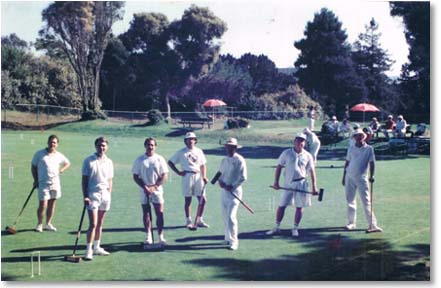
|
| This photo was taken probably in the early nineties on Stern Grove's north lawn, after Wayne Rodoni became the first national champion in the club, and before the later champions joined the club. Dave Dondero might have taken the photo. |
Along the way, the club faced the same kind of issues that all volunteer-based organization endure, and mostly handled them without actually killing anyone in noisy disputes - especially on the board - that seemed daunting at the time, but now in retrospect look petty. Example: two members of the board drank too much and were inclined to be rowdy and contentious in evening meetings; when the board meetings were changed to midday at lunch, that problem disappeared.
How to manage something without a title
For this entire time - especially after Mike Orgill's attention moved north to Sonoma-Cutrer - Bob Alman was actually managing the club, although someone else was the president. The president was very useful in the meetings with city boards, because his main occupation was building, and real estate. He played croquet pretty well, although his wife had no interest at all in the game, only the social connections. She was a court reporter with a small business that managed and assigned other court reporters, and Bob used her office to create mailings and brochures and promotions of all sorts, and copy them and mail them out, for more than a decade in the postal mail, then finally by email.
At some time- and Bob does not remember exactly when - the members, led by Texans' Hood and Margaret Chatham, who held the presidential pair in contempt and said that they didn't actually DO anything for the club - revolted from the established order and said that Bob should be the president, because he was the guy who had made everything happen and who continued to manage the development of the club. Bob said things were fine the way they were.
But the Chathams were adamant. If Bob wouldn't run, they would find somebody else who would. That person turned out to be a perfectly nice guy who had joined the club soon after the 19th Avenue lawns were open for croquet.
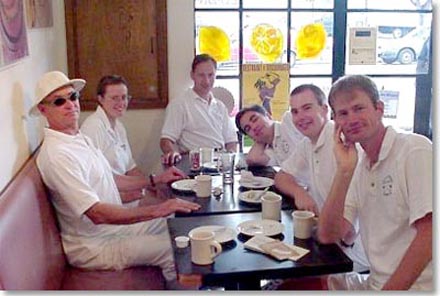
|
| In 2000, Dr. Ian Plummer brought his Oxford students to America. Bob Alman, (left) hosted them in Northern California with the help of Ellery McClatchy and the people at Sonoma-Cutrer. Jenny Williams (soon to be Jenny Clarke, second from left) was studying at Stanford at the time. Others are Mark Wormald, Nic Farhi, John Taylor, and Ian. Jonny Willson snapped the picture of us all lunching in the Marina. |
Bob had nothing against the man, who owned many interesting rental properties, but couldn't imagine him managing the club. Bob called him and asked, "How are you going to manage the club?" The answer was, "I'm going to delegate." That meant to Bob that he, himself, would continue to do the work, but in another office. So Bob was persuaded to run, himself, after all, and informed everyone that he was a candidate.
Clearly, most people were going to vote for Bob, and Ed Breuer made a failed effort to avoid the election, but clearly the voting had to be done. The vote was so overwhelmingly in Bob's favor that the board did not announce the tally. Very little changed after that point, except for one change that no one in the club considered significant, except Bob:
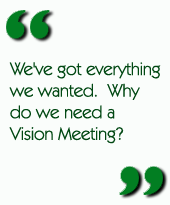 Bob had established, in 1985, an annual Vision Meeting for the entire membership, in which they would collectively and with much discussion set their goals specifically, each with a time-lined target date. When Bob proposed the next meeting for 1992, the Board members said, "But Bob, we don't need to do that any more: We already have everything we said we wanted: Two lawns, a prestigious Open, a large membership, great players, a huge bank account...so why should we have a Vision Meeting?"
Bob had established, in 1985, an annual Vision Meeting for the entire membership, in which they would collectively and with much discussion set their goals specifically, each with a time-lined target date. When Bob proposed the next meeting for 1992, the Board members said, "But Bob, we don't need to do that any more: We already have everything we said we wanted: Two lawns, a prestigious Open, a large membership, great players, a huge bank account...so why should we have a Vision Meeting?"
It was a good question, and Bob knew they wouldn't accept his answer: that any organization operating itself without a well articulated vision of its future will begin to decline. It was absolutely true, but saying it would sound entirely too New Agey.
So Bob dates the decline of the club to the cessation of those annual Vision Meetings, in 1992 - precisely the time when the club was at its peak and its 64-player Open had become a stronger players' event than the USCA national championships, held annually in the east.
Discovering the internet and creating the websites
| Public Penance and Pavlov |
|
Bob committed a huge error, publicly - somewhere around 1996. There was no doubt that he did it intentionally (albeit without much conscious awareness of its effects) and some people thought that because of it his croquet career was over. Doing public penance was necessary and properly humiliating, but what was he going to do about himSelf? He was forced to recognize himSelf as the kind of Self he, himSelf, would hold in contempt for doing such a thing. So his only recourse was to change himSelf: to become his own Pavlov's dog upon which to perform a behaviorist remedy, from the outside in, intentionally, moment by moment. He thinks it worked. He believes he is not today the kind of Self who would do something like that again.
|
Why not? Bob Alman didn't have a computer at the time, but he did have one of those enormous "automatic typewriters" which could produce DOS disks that could be mailed to Bob Henry in Silicon Valley. All he had to do was write the site, and Bob Henry could put what he wrote on "the web."
Why not? Bob thought he should call Bill Berne in Carolina, president of the USCA, to tell him what they had in mind. When they spoke on the phone, Bill's first question was, "How much would it cost?'" Nothing, Bob said. The second was, "What's the web?" Bob explained briefly. Bill Berne said it sounded harmless enough, but he should run it by the USCA Management Committee.
Seeking the blessing of the USCA management committee
Later in the week, Berne called back to say the Management Committee didn't mind, but that they told him the web was just a passing fad. Bob briefly explained that with Bob Henry's help, he would put online a website that would be basically a brochure, with a directory of local clubs and other informational features, which would make USCA croquet sound and look appealing.
Within a week after that conversation, the first USCA Website was online at www.CroquetAmerica.com. (Bob Alman found out later that he had been beaten to "Croquet.com" by only a month or so by Steve Dimond, who much later sold that URL as a merchandising site for a handsome profit.)
It seems incredible now, in his memory, that he did not have a web connection himself - not until he decided, six month later, to invent CROQUET WORLD ONLINE MAGAZINE, with Mike Orgill's help and encouragement. Bob would go the public library frequently to check out the site and telephone Bob Henry about changes. Both Bobs were excited and pleased when they found that at the end of the first week, there had been more than a thousand hits - and probably no more than half of those done by the Bobs themselves, checking and admiring their work.
Within six months Bob realized the USCA website was too limited to truly represent the sport to the greater public, and that he should also put up a magazine, to be called CroquetWorld.com, designed for global news of the sport and written for non-players as well as players. As you can see in the present site's 1996 archive, one of the first events reported was the WCF World Championship in Australia, covered copiously, with sometimes two articles a day. Bob Henry soon threatened to quit, so Bob Alman promised not to send him new stuff any more often than once a week.
As both websites rapidly gained hits and visitors another Cybersmart club member, Adam Stock, told Bob Alman the sites needed to have better designs and more features. So with two websites already working successfully, Bob asked Ellery McClatchy, who had already donated things to the club, for a grant to redesign and expand both sites. Ellery generously agreed to a $24,000 grant that would enable Adam and Bob to put up sites that would look very good and generate even more traffic. "Because I like what you're doing," Ellery explained.
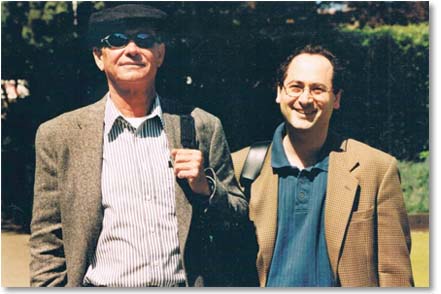
|
| Bob Alman with Adam Stock, the club member who designed CroquetAmerica.com and CroquetWorld.com and spent many hours working on it and improving it in the late nineties. The CroquetAmerica design lasted eight years--while the CroquetWorld design has lasted until 2019. |
Adam wanted to do an interactive feature of the website - for the Grand Prix and rankings - so that meant interfacing with the USCA offices in West Palm Beach. Bob spent several weeks in West Palm Beach at USCA headquarters, to work out ways to make the Grand Prix system work well online and to draft form letters the USCA could use to respond to public inquiries generated by the websites.
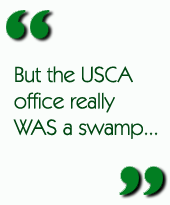
Two years later, Bob went back to the USCA office for another visit, to do further coordination with the USCA staff during the presidency of Dan Mahoney. (The San Francisco Croquet Club had enabled Palm Beacher Dan Mahoney to be elected by overtly publicizing his support in the West in an era when USCA croquet was still in turmoil over the "western killer" issue.) During that visit, Bob couldn't help noticing that the USCA was a swamp, with three or four women at desks apparently campaigning for attention when anyone came through the door, and no one "in charge."
So "swamp" was the word he used to describe it in his weekly email to the San Francisco Croquet Club. Someone sent it to Dan, who was offended by it and told Bob, "I was going to reimburse you for your expenses, but I didn't like that email at all." So be it.
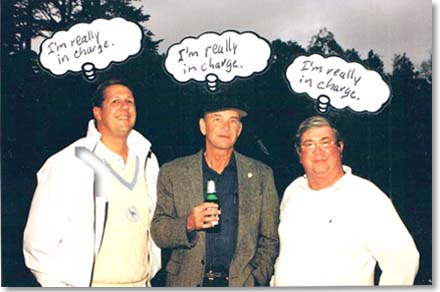
|
| Bert Myer (right) enjoyed caption-writing on his snapshots. He's making a joke about power, during one of the two visits Dan Mahoney made to the Open when he was president of the USCA. Bert was there to write a story about the San Francisco Open for the USCA Annual. USCA presidents Bill Berne and Foxy Carter also came to play. When CFA stalwart Mike Gibbons came with his wife Cynthia he pronounced the Open "the best-kept secret in American croquet." Nevertheless, the tournament was fully subscribed, with 64 players in three flights, in its last ten years. |
Mixed blessing of the USCA's "elite class" image
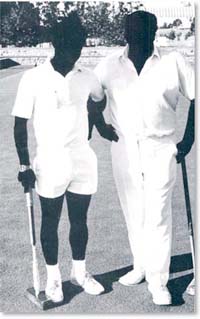
|
| In the first issue of Croquet Magazine Bob had the idea of blacking out two of the best-known figures in organized croquet at the time to help us pose an editorial question on the arbitrary nature of racial distinctions and the exaggerated importance of costuming in the sport of croquet. In case you don't recognize the real human beings behind the uniforms in front of the stonework of Sonoma-Cutrer: the one on the left is Damon Bidencope; on the right is Neil Spooner. Both these pros had a lot to do with making Northern California the player powerhouse it was in the 90s. |
But much later - more than a decade later, dying of cancer - Osborn would telephone Bob in San Francisco and engage in a moving half-hour conversation that concluded with what Bob later described as "the ideal Jack Osborn back-handed compliment." Jack's precise words were, "I always knew your intentions were good, Bob."
When socially ambitious San Franciscans heard about the San Francisco Croquet Club, they naturally wanted to join, to mix with the higher class of human being touted in the national publicity. Their aggression inevitably drove away the socially prominent people they wanted to mix with, especially at croquet parties. In San Francisco, it meant that the actual "socialites" would stop playing croquet publicly; throughout the US, it would mean that the croquet they played would be on courts they built at their own estates or arranged to be installed at their country clubs.
But it also meant that often, wealthy people who knew nothing about croquet would phone Bob and generously offer to give the opening party for the Open - sometimes in an elaborate Russian Hill penthouse or Pacific Heights mansion. Most were probably puzzled by the distinctly non-socialite players who came to their party. In only a few cases, they became members and actually learned to play the game.
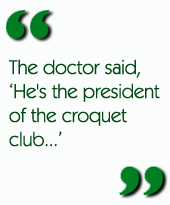 Alman was dirt poor at the time, and never had any social ambitions, but he was blessed more than once in practical ways by the reputation with which the SFCC had been endowed by Osborn's publicity for the sport. When he encountered his first retinal detachment at Ellery McClatchy's tournament on a mountaintop near Pope Valley and drove to the nearest hospital, in Santa Rosa, the examining physician told him he needed to have the best doctor available for an operation as soon as possible. He overheard the end of the ensuing telephone conversation, including "He's the president of the croquet club" - an answer to a question about finances, obviously. Presto! So Bob did not go blind.
Alman was dirt poor at the time, and never had any social ambitions, but he was blessed more than once in practical ways by the reputation with which the SFCC had been endowed by Osborn's publicity for the sport. When he encountered his first retinal detachment at Ellery McClatchy's tournament on a mountaintop near Pope Valley and drove to the nearest hospital, in Santa Rosa, the examining physician told him he needed to have the best doctor available for an operation as soon as possible. He overheard the end of the ensuing telephone conversation, including "He's the president of the croquet club" - an answer to a question about finances, obviously. Presto! So Bob did not go blind.
A thief, a headless corpse, and drums on Hippie Hill
The three main lawns used for the 7-court San Francisco Open were "the jewel of the park system," the three bowling lawns in the most active and interesting part of Golden Gate Park, several miles north of the club's Stern Grove lawns, and on a good day, a half hour away from the Oakland bowling lawns, also rented. Drums from Hippie Hill often accompanied play on Lawn One in front of the bowling clubhouse, and a constant stream of pedestrian and vehicular traffic produced more than just public exposure for "real croquet."
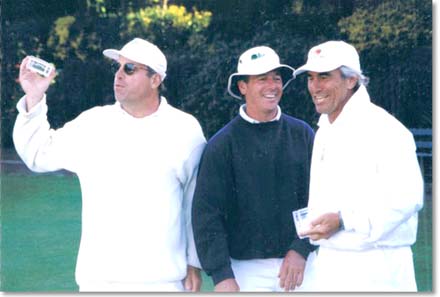
|
| Bob Kroeger, Wayne Rodoni, and Mike Zuro all seem to be delighted about something or other--maybe its the modesty of their San Francisco Open trophies. |
The drama around the court often exceeded the spectacle of major-player competition that might have been "invisible" to the public. There was the time when play was interrupted by shouts of "stop, thief!" and a black-clad figure jumped over a hedge onto Lawn Two into the middle of a doubles game that included a former member of the Los Angeles police and a very small Jacques Fournier. The cop tackled the thief and players piled on top, while the victim complained, "You're hurting me," and was soon taken away by the SF police.
Another year, the police interviewed Bob Alman again. He had been the person who had unwittingly thrown garbage from the SF Open on top of a headless corpse in a dumpster nearby. Bob told them everything he knew about the headless corpse - which was nothing.
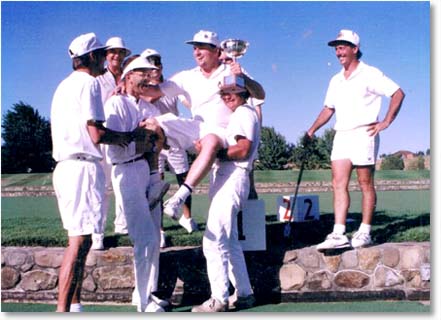
|
| John and Anne Taves were gone, but in the second year of close team competition, San Francisco managed to defeat Sonoma-Cutrer and win the Golden Gate Challenge Cup. |
Atrocities of American Rules play on pubic display
Whether so many of those international players lost because they really didn't understand American rules, or were put out of competition because of the "flaws" in the American game can still be debated.
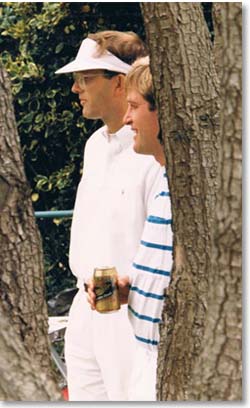
|
| Dr. Carl Hanson and John Taves often stood between the trees on the berm commenting on the play below. They played equally well, and Taves--like several other members of the SFCC--was on many USCA international teams. Hanson, frequently a winner or finalist in the SF Open, was constrained by his medical career. |
So they watched Tony Steven run the longest two-ball break Bob had ever seen on any court, in any game. They watched Tony Hall lose to an embarrassed Wayne Rodoni when Tony ran Rover in the "wrong" direction. They witnessed Robert Fulford being punished for an expert side-angle shot at Rover which pegged him out on Wayne Rodoni's perfectly set court. (That atrocity is still possible on a well-set court in American rules, long past any compelling justification for it.)
For at least five years running, at a time when Northern California was producing most of the USCA's International Team, the SF Open was the strongest players' tournament in the US, surpassing the National Championship played in the East. Because of the club's importance, all the presidents of the USCA who succeeded Jack Osborn came out to play, at least once - Foxy Carter, Bill Berne, Dan Mahoney, and Dan Mahoney again with Anne Frost Robinson, the only truly successful "Executive Director" of the USCA.
Ending a great annual tournament at its peak
Before the 2000 event, the managers had voted to retire the Open. They had produced it 16 times and could find no further way to improve it. It could only decline from that point onward. So when they made the announcement at the 2000 Open during the trophy presentation of exquisite crystal obelisks, the players were surprised.
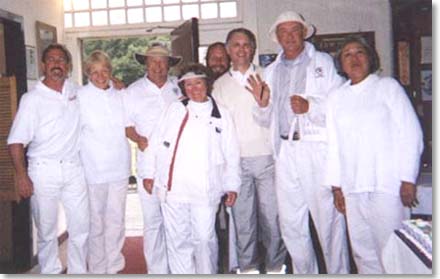
|
| Sheltered in the clubhouse from a day-long drizzle following the May 2000 trophy ceremony of the last San Francisco Open, the production team smiles goodbye: Wayne Rodoni, Karen Collingwood, John Taylor, Rosemarie Taylor, David Dill, Ed Breuer, Bob Alman (waving goodbye), and Elaine Fong. (Not pictured: Reuben Edwards.) |
Ed Breuer told Bob Alman privately, "It's because you're going to move to Florida." Bob told him, accurately and truly, that he had no intention of moving to Florida, he was just doing some preliminary organizing and planning work for Chuck Steuber, the CFA president whose mission was to create a magnificent national home for the sport, which required him to go to West Palm Beach from time to time.
No one knows what has become of Ed Breuer. Like Carl Hanson - who could have been a national champion if he taken time off from doctoring - he may have given up croquet. Rodoni gave up competition because, he told Bob, "I've already won everything. Now all I could do is lose." John and Anne Taves moved to Seattle. When Jim Audas came to find a game in Stern Grove, he often didn't succeed. And he didn't want to play in Oakland. Mike was long gone, as president of Sonoma-Cutrer.
Ed Breuer turned out to be a prophet, of a kind. Bob did move to Florida later that year, permanently. And after he was in Florida, he wrote an article about "ending the San Francisco Open" which concluded this way:
"The new frontier of American croquet is no longer way out west; oddly, it has moved back East, back to Florida, back to West Palm Beach. All the experimentation and innovation we did in the West will be multiplied ten times over at the National Croquet Center. The modest San Francisco experiments in public court programs will be duplicated and expanded at a National Center which will provide lawns not only for the country's finest resort-class club, but also for public and corporate groups to provide as many workable models as possible for marketing the sport more broadly throughout the Americas."
That was the plan, anyway. Continue to Part Four of this memoir, which recounts how it ALMOST happened.
Parts Four and Five of Bob Alman's croquet memoir will be published here eventually, to complete the story of the part of his life that includes croquet, as well as the new life he invented in West Palm Beach when he no longer had a reason to go the Center every day.